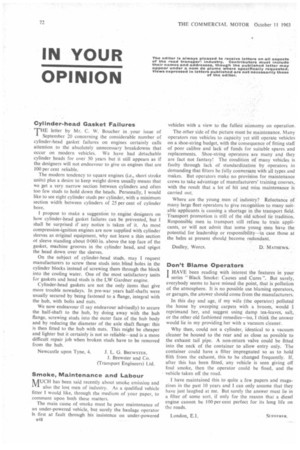Cylinder-head Gasket Failures
Page 74

If you've noticed an error in this article please click here to report it so we can fix it.
THE letter by Mr. C. W. Boucher in your issue of September 20 concerning the considerable number of cylinder-head gasket failures on engines certainly calls attention to the absolutely unnecessary breakdowns that occur on modern vehicles. We have had detachable cylinder heads for over 50 years but it still appears as if the designers will not endeavour to give us engines that are 100 per cent reliable.
The modern tendency to square engines (i.e., short stroke units) plus a desire to keep weight down usually means that we get a very narrow section between cylinders and often too few studs to hold down the heads. Personally, I would like to see eight cylinder studs per cylinder, with a minimum section width between cylinders of 25 per cent of cylinder bore.
I propose to make a suggestion to engine designers on how cylinder-head gasket failures can be prevented, but I shall be surprised if any notice is taken of it. As most compression-ignition engines are now supplied with cylinder sleeves as original equipment, why not leave a thin section of sleeve standing about 0060 in. above the top face of the gasket, machine grooves in the cylinder head, and spigot the head down over the sleeves.
On the subject of cylinder-head studs, may I request manufacturers to screw these studs into, blind holes in the cylinder blocks instead of screwing them through the block into the cooling water. One of the most satisfactory Units for gaskets and head studs is the LW Gardner engine.
Cylinder-head gaskets are not the only items that give more trouble nowadays. In pre-war years half-shafts were usually secured by being fastened to a flange, integral with the hub, with bolts and nuts.
We now endeavour (I say endeavour advisedly) to secure the half-shaft to the hub, by doing away with the hub flange, screwing studs into the outer face of the hub body and by reducing the diameter of the axle shaft flange: this is then fitted to the hub with nuts. This might be cheaper and lighter but it certainly is not so reliable—and is a more difficult repair job when broken studs have to be removed from the hub.
Newcastle upon Tyne, 4. J. L. G. BREWSTER,
J. Brewster and Co.
(Transport Engineers) Ltd.




















































































































